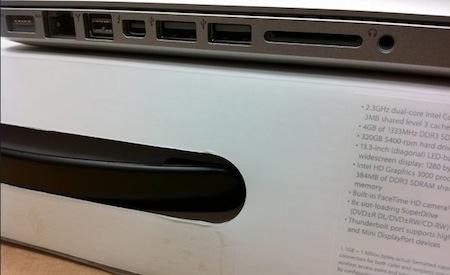Interesting finding in the new MacBook Pro, how is implemented Thunderbolt, Intel's technology currently used only by Apple. As we explained, Thunderbolt can carry data over a cable with a throughput of 10 Gbit / s. In its current implementation, two types of flows are used: DisplayPort 1.2 and PCI-Express, with 4 rows at a standard 1.1, which in theory can reach the 10 gigabit per second technology.
In the MacBook Pro 15 and 17 inches, using a platform Sandy Bridge, it is interesting that Thunderbolt is wired directly to the PCI-Express CPU, not on the chipset. Explain. In a unit on Sandy Bridge, there are two PCI-Express: the processor, which has 16 lines used with either a port or two ports 16x 8x chipset and the Cougar Point, which has 8 lines.
Technically, it is possible to connect Thunderbolt on the chipset Apple uses only four lines in its machines (FireWire, Ethernet, ExpressCard and Wi-Fi). However, Apple decided to wire Thunderbolt on the CPU and leaving "only" 8 lines to the graphics card. In practice, the limitation of the graphics card has no impact - the transition from 16x to 8x PCI-Express 2.0 has an impact of 1 to 2% - Thunderbolt and integrate the CPU allows avoid the limitation of the DMI link between the processor and chipset.
Indeed, if the chipset supports 8 PCI-Express and SATA 6 Gbit / s, the connection between processor and chipset is limited to the equivalent of 4 PCI-Express 2.0. Remains to be seen whether Thunderbolt will land in force in the PC or if the technology will remain confined to the Apple devices. 


In the MacBook Pro 15 and 17 inches, using a platform Sandy Bridge, it is interesting that Thunderbolt is wired directly to the PCI-Express CPU, not on the chipset. Explain. In a unit on Sandy Bridge, there are two PCI-Express: the processor, which has 16 lines used with either a port or two ports 16x 8x chipset and the Cougar Point, which has 8 lines.
Technically, it is possible to connect Thunderbolt on the chipset Apple uses only four lines in its machines (FireWire, Ethernet, ExpressCard and Wi-Fi). However, Apple decided to wire Thunderbolt on the CPU and leaving "only" 8 lines to the graphics card. In practice, the limitation of the graphics card has no impact - the transition from 16x to 8x PCI-Express 2.0 has an impact of 1 to 2% - Thunderbolt and integrate the CPU allows avoid the limitation of the DMI link between the processor and chipset.
Indeed, if the chipset supports 8 PCI-Express and SATA 6 Gbit / s, the connection between processor and chipset is limited to the equivalent of 4 PCI-Express 2.0. Remains to be seen whether Thunderbolt will land in force in the PC or if the technology will remain confined to the Apple devices.



No comments:
Post a Comment